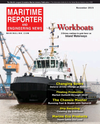
Page 24: of Maritime Reporter Magazine (November 2015)
Workboat Edition
Read this page in Pdf, Flash or Html5 edition of November 2015 Maritime Reporter Magazine
TECHNICAL UPDATE
Ballast Water Management in the ? eld
Put to the Test
BY LAWRENCE YOUNAN
Variable Fluorescence for the Validation of Ballast Water Sampling Techniques Aboard the RV Meteor urner Designs, along with sci- untreated surface samples, UV treated labeling techniques. Turner Designs’ under 200 samples collected during this entists from around the world surface samples, or ballast tank sam- Ballast-Check 2 was used to estimate cruise. The Ballast-Check 2 analyzed participated in a research ples that were held for a speci? c period phytoplankton abundance as cells/ml as roughly 600 samples as everything was
Tcruise aboard the RV Meteor, of time. The collected samples were well as assess the activity of those cells done in triplicate. a vessel owned by the Federal Repub- fractionated according to size class of using ? uorometric techniques. There lic of Germany through the Ministry of organisms and fractionates were indi- were 3 sampling events per day, 2 splits Ballast-Check 2
Research and Technology (BMFT) and vidually analyzed using ? uorometric, per sampling event, and 3 fractionates The Ballast-Check 2 is a small, light- funded by the German Research Foun- microscopic, ATP, FDA, and molecular per split over 11 days for a total of just weight, highly durable handheld ? uo- dation (DFG). The goal of this cruise rometer. It is dustproof, waterproof, bat- was focused on ballast water sampling tery powered, has internal data logging, techniques and protocols. Various instru- and is speci? cally designed for rapid ments were used to test collected ballast indicative tests of whether ballast water water enabling researchers to determine is in compliance with current discharge ef? ciency for the various sampling tech- standards for phytoplankton in the 10-50 niques employed. The preferred tech- micron size class. This determination is nique would then be used for sampling based on two important measurements ballast water from ships for the purpose made by the Ballast-Check 2 for charac- of collecting an appropriate sample when terizing algal constituents in ballast wa- checking if ships’ ballast waters comply ter: ABUNDANCE and ACTIVITY of with ballast discharge standards. algae. Factory set, the Ballast-Check 2 is con? gured for use right out of the box,
Cruise Details with simple one-button measurements
The RV Meteor is a German research that yield accurate estimates in less than vessel stationed in Hamburg, Germany. 1 minute.
Financial and logistical contributions The Ballast-Check 2 has been used from the German Federal Maritime and in many laboratory and ? eld trials for
Hydrographic Agency (BSH) in part- testing the success rate of a variety of nership with the federal Department of treatments used to treat ballast water.
Fisheries and Oceans Canada (DFO) en- Treatments such as chlorination and abled this 11 day research cruise which UV exposure are used to reduce the began off of the coast of Africa in Min- abundance of organisms in ballast wa- delo, located on the Cape Verde Islands, ter to make the water safe for discharge and ended in Hamburg, Germany. This thereby reducing the risk of introducing cruise occurred in June of 2015, the At- exotic/invasive species. Veri? cation lantic Ocean’s most oligotrophic time techniques such as microscopy, ? ow- of the year. Headed by Manfred Rolke cytometry, and wet chemistry are used to from BSH, many top scientists, instru- determine whether treatments are effec- ment vendors, and ballast water treat- tive, but these techniques require expen- ment companies from various parts of sive, laborious equipment and trained the world were aboard to help this effort. personnel who can not only operate but
Different water types were encountered also analyze and make decisions based as shown from the cruise track in ? gure on detailed results. The Ballast-Check 1 to the right. Samples were analyzed 2 provides quick indicative results for from oligotrophic (saline) waters to gross exceedance of discharge standards highly turbid river (fresh) waters allow- as a ? rst step toward determining wheth- ing for a robust data set. er ballast water is safe to discharge or instead requires further testing for ? nal
Figure 1: Cruise track from M116/2 research cruise aboard RV Meteor begin-
Methods determination.
ning in Mindelo on June 4, 2015 and ending in Hamburg on June 15, 2015.
Water samples analyzed were either 24 Maritime Reporter & Engineering News • NOVEMBER 2015
MR #11 (18-25).indd 24 10/30/2015 9:56:33 AM

 23
23

 25
25
